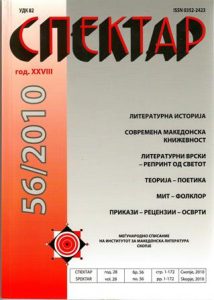РОДОТ И АРХЕТИПОТ ВО ДРАМИТЕ НА ТЕКИ ДЕРВИШИ И НА ГОЦЕ СМИЛЕВСКИ
GENDER AND ARCHETYPES IN THE PLAYS OF TEKI DERVISHI AND GOCE SMILEVSKI
Author(s): Nataša AvramovskaSubject(s): Gender Studies, Drama
Published by: Институт за македонска литература
Keywords: mythic images; Earth Mother; famm fatal; son-eunuch; drama; uroborical play's setting; dramatic action; dramatis personaе-apotropaioi; „familial scenario“ of sexuality; intertextuality
Summary/Abstract: The theatrical works by Teki Dervishi, The Hill of Sorrow, and by Goce Smilevski, Conversation with Spinoza (a circus act in five parts), are bound by a common (almost identical) dramatic unfolding that maps out the circle of infinite oneness of the uroboric body: the great snake that swallows its own tail. It is the kind of dramatic interplay which maps out the circle of the unbreakable bond between the mother’s womb and the bearings of her son’s sensuality (as in: body, source of sinning). The lining of the circle marks the infinity of the sensuality’s incarnations, its eroticism, its sex; it underlines their collectivity, a oneness with the all-encompassing and all-bearing body of the mother, which in turn, appears as an apotropaioi (in its magic, protective function) character positioned at the gates of the dramatic world: at its entrance and at its exit. Namely, at the entrance/exit of being itself: in the interim process between life and death. What these two plays bear in common, as a result of their intertextual and intercultural dialoguing when dealing with the question of gender and archetypes, is the conjoined reinforcement of the archetypal meaning of man’s mother born out of corporeality and sensuality. In Smilevski’s play, what takes center stage is the theme of sexuality, that is the dialogue carried out betwixt the world of sexuality and Spinoza’s philosophy, which is resolved at the level of archetypal imagery. In Dervishi’s play, on the other hand, sexuality is always twice-removed from the archetypal character of the Mother, and her many mythic incarnations. What is nonetheless key for the platform of comparing these two pieces based on the commonality of gender and archetypes could be found in ‘the familial scenario’ of sexuality that the two respectively voice.
Journal: Спектар
- Issue Year: 2010
- Issue No: 56
- Page Range: 73-88
- Page Count: 16
- Language: Macedonian

